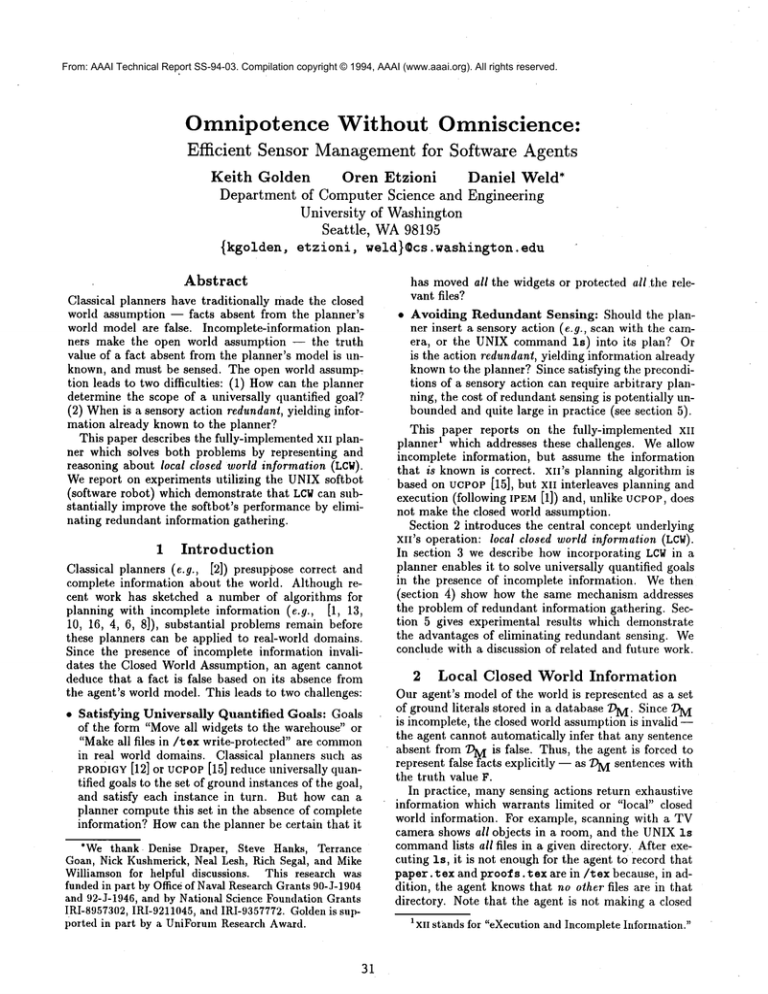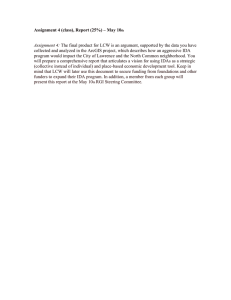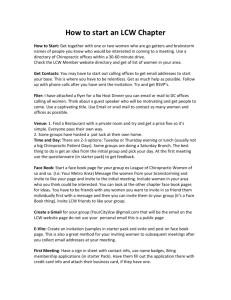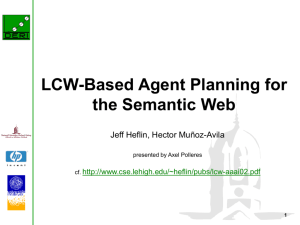
From: AAAI Technical Report SS-94-03. Compilation copyright © 1994, AAAI (www.aaai.org). All rights reserved.
Omnipotence
Efficient
Without
Omniscience:
Sensor Managementfor Software Agents
Keith
Golden
Oren Etzioni
Daniel
Weld*
Department of Computer Science and Engineering
University
of Washington
Seattle,
WA 98195
{kgolden, etzioni, weld}@cs.washington.edu
Abstract
Classical planners have traditionally made the closed
world assumption -- facts absent from the planner’s
world model are false. Incomplete-information planners make the open world assumption -- the truth
value of a fact absent from the planner’s model is unknown, and must be sensed. The open world assump:
tion leads to two difficulties: (1) Howcan the planner
determine the scope of a universally quantified goal?
(2) Whenis a sensory action redundant, yielding information already known to the planner?
This paper describes the fully-implemented xII planner which solves both problems by representing and
reasoning about local closed world information (LOW).
Wereport on experiments utilizing the UNIXsoftbot
(software robot) which demonstrate that LCWcan substantially improve the softbot’s performance by eliminating redundant information gathering.
1 Introduction
Classical planners (e.g., [2]) presuppose correct and
complete information about the world. Although recent work has sketched a number of algorithms for
planning with incomplete information (e.g., [1, 13,
10, 16, 4, 6, 8]), substantial problems remain before
these planners can be applied to real-world domains.
Since the presence of incomplete information invalidates the Closed World Assumption, an agent cannot
deduce that a fact is false based on its absence from
the agent’s world model. This leads to two challenges:
¯ Satisfying Universally Quantified Goals: Goals
of the form "Move all widgets to the warehouse" or
"Makeall files in/rex write-protected" are common
in real world domains. Classical planners such as
PRODIGY
[12] or UCPOP
[15] reduce universally quantified goals to the set of groundinstances of the goal,
and satisfy each instance in turn. But how can a
planner compute this set in the absence of complete
information? Howcan the planner be certain that it
*We thank Denise Draper, Steve Hanks, Terrance
Goan, Nick Kushmerick, Neal Lesh, Rich Segal, and Mike
Williamson for helpful discussions. This research was
fundedin part by Office of NavalResearchGrants 90-J-1904
and 92-J-1946, and by NationMScience Foundation Grants
!RI-8957302,IRI-9211045,and IRI-9357772.Goldenis supported in part by a UniForuln Research Award.
31
has movedall the widgets or protected all the relevant files?
¯ Avoiding Redundant Sensing: Should the planner insert a sensory action (e.g., scan with the camera, or the UNIXcommand ls) into its plan? Or
is the action redundant, yielding information already
knownto the planner? Since satisfying the preconditions of a sensory action can require arbitrary planning, the cost of redundant sensing is potentially unboundedand quite large in practice (see section 5).
This paper reports on the fully-implemented xII
planner 1 which addresses these challenges. Weallow
incomplete information, but assume the information
that is knownis correct, xII’s planning algorithm is
based on ucPoP [15], but xII interleaves planning and
execution (following IPEM [1]) and, unlike vcPoP, does
not make the closed world assumption.
Section 2 introduces the central concept underlying
xII’s operation: local closed world information (LCW).
In section 3 we describe how incorporating LCWin a
planner enables it to solve universally quantified goals
in the presence of incomplete information. Wethen
(section 4) show how the same mechanism addresses
the problem of redundant information gathering. Section 5 gives experimental results which demonstrate
the advantages of eliminating redundant sensing. We
conclude with a discussion of related and future work.
2 Local
Closed
World Information
Our agent’s model of the world is represented as a set
of ground literals stored in a database DM. Since
is incomplete, the closed world assumption is invalidthe agent cannot automatically infer that any sentence
absent from ~ is false. Thus, the agent is forced to
represent false facts explicitly -- as ~ sentences with
the truth value F.
In practice, manysensing actions return exhaustive
information which warrants limited or "local" closed
world information. For example, scanning with a TV
camera shows all objects in a room, and the UNIXls
command
lists all files in a given directory. After executing as, it is not enough for the agent to record that
paper, rex and proofs, rex are in/rex because, in addition, the agent knowsthat no other files are in that
directory. Note that the agent is not making a closed
1 xII stands for "eXecutionand IncompleteInformation."
world assumption. Rather, the agent has executed an
action that yields closed world information.
Although
the
agent
now knows that
paxent.dir(foo,/tex)
is false, it is impractical for
the agent to store this information explicitly in T~VI,
since there is an infinite numberof such sentences. Instead, the agent represents closed world information
explicitly in a meta-level database, :/)C, containing sentences of the form LCW((I))that record where the agent
has closed world information. LCW(¢)means that for
all variable substitutions 6, if the ground sentence ¢0
is true in the world then fro is represented in /)M’
For instance, we represent the fact that 79Mcontains
all the files in /tex with LCW(parent.dir(f,/tex))
and that it contains the length of all such files with
LCW(parent. dir (f,/rex) hlength (f, l)
Whenasked whether an atomic sentence ~ is true,
the agent first checksto see if ¯ is in I~IVI. If it is, then
the agent returns the truth value (T or F) associated
with the sentence. However, if ~ ~ ~Vl then ~ could
be either F or U (unknown). To resolve this ambiguity,
the agent checks whether :DC entails LCW(~).If so,
is F, otherwiseit is U.
2.1 LCW Updates
As the agent is informed of the changes to the external
world -- through its own actions or through the actions of other agents -- it can gain and lose LCW;these
changes must be recorded in :DC. Weassume here, and
throughout, the absence of hidden exogenous events
that invalidate xn’s information. In other words, we
assume that the rate of change in the world is slower
than the rate at which XII plans and executes. This is
the standard assumption of correct information made
~
by most planners.
When xII executes an operator which ensures
that :D M contains all instances
of ff that are
true in the world, xlI adds a sentence LCW((I))
to /)C’
For example, XII is given an axiom
stating that each file has a unique word count.
Thus, executing the UNIX command wc paper.rex
adds the sentence LCW(word. count (paper.rex,c))
to 7) C as well as adding the actual length (e.g.,
word.count(paper.rex,42))
to M. Si nce th e is
commandhas a universally quantified effect,, executing
is /rex yields LCW(parent. dir(f,/rex)
It would be cumbersome if the author of each operator were forced to list its LCW
effects. In fact, this
is unnecessary, xII automatically elaborates operator
schemata with LCW
effects. Even in the worst case, this
compilation process takes time linear in the length of
the operator schemata and the number of unique-value
axioms [9].
Observational effects (e.g., those ofls) can only create LCW,but causal effects can both create and destroy
LCW.3 For example, deleting all files in/rex pTvvides
2In fact, the softbot relaxes this assumptionby associating expiration times with beliefs in :DMand :DC and by
recovering from errors that result from incorrect information. However,a discussion of this mechanismis beyond
the scope of this paper.
3XlI operator schemata explicitly distinguish between
32
complete information on the contents of the directory
regardless of what the agent knew previously. Compressing a file in/rex, on the other hand, invalidates
previously obtained LCW
of the lengths of all files in
that directory.
The theory behind LCWis complex; [3] defines LCW
formally, explains the connection to circumscription,
and presents a set of tractable update rules for the
case of conjunctive LCWsentences. In this paper, we
show how to incorporate conjunctive LCWinto a least
commitment planner and argue that this addresses the
challenges described in section 1: satisfying universally
quantified goals and avoiding redundant sensing.
3 Universally
quantified
goals
In this section we explain how xn utilizes LCWto satisfy universally quantified goals. Traditionally, planners that have dealt with goals of the form "Forall v of
type t make A(v) true" have done so by expanding the
goal into a universally-ground, conjunctive goal called
the universal base. The universal base of such a sentence equalS the conjunction A1 A ... A A. in which
the Ais correspond to each possible interpretation of
A(v) under the universe of discourse, {C~,...,C.},
i.e. the possible objects of type t [7, p. 10]. In
each Ai, all references to v have been replaced with
the constant Ci. For example, suppose that pf denotes the type corresponding to the files in the directory /papers and that there are two such files:
C1 = a.dvi and C2 = b.dvi. Then the universal
base of "Forall f of type pf make printed(f) true"
print ed (a. dvi ) hprint ed (b. dvi
A classical planner can satisfy V goals by subgoaling
to achieve the universal base, but this strategy relies on
the closed world assumption. Only by assuming that
all membersof the universe of discourse are known(i. e.,
represented in the model) can one be confident that
the universal base is equivalent to the V goal. Since
the presence of incomplete information invalidates the
closed world assumption, the XII planner uses two new
mechanismsfor satisfying V goals:
1. Sometimesit is possible to directly support a V goal
with a V effect, without expanding the universal base.
For example, given the goal of having all files in a directory group readable, XII can simply execute clmod
g+r *; it doesn’t need to knowwhich files (if any) are
in the directory. Section 3.1 elaborates this option.
2. Alternatively, xH can subgoal on obtaining LCWon
the type (~i(vi) of each universal variable vi in the
goal. Oncexn has LCW((I)i), the universe of discourse
for vl is completely represented in its world model.
At this point XHgenerates the universal base and
subgoals on achieving it. Note that this strategy
differs from the classical case since it involves interleaved planning and execution. Given the goal of
printing all files in/papers, XII would plan and execute an ls command,then plan to print each file
causal effects (that changethe state of the external world)
and observationaleffects (that only changethe state of XlFs
model)as explained in [4].
it found, and then execute that plan. Section 3.2
describes this option in detail.
For completeness, XII also considers combinations of
these mechanismsto solve a single V goal; see [9] for
details. 4 In the remainder of this section we explain
these two techniques in more detail.
3.1
Protecting
V links
In the simplest case, XII can use a universally quantified
effect to directly support a universally quantified goal.
However,V goals, like ordinary goals, can get clobbered
by subgoal interactions; to avoid this, xII uses an extension of the causal link [11] mechanismused for protecting other goals. A causal link is a triple, written
Apa--~A~., where G is a goal, Apis the step that produces
G and Ac is the step that consumes G. Werefer to G
as the label of the link. WhenxII supports a V goal directly (i.e., without expanding into the universal base)
it creates a link whoselabel, G, is a universally quantified sentence (instead of the traditional literal); we call
such links "V links." In general, a link is threatened
when some other step, At, has an effect that possibly interferes with G and At can possibly be executed
between Ap and Ac. For normal links, interference is
defined as having an effect that unifies with -~G. Such
an effect also threatens a V link, but V links are also
threatened by effects that possibly add an object to
the quantifier’s universe of discourse. For example, if
XII adds a chmod g+r * step to achieve the goal of
having all files in a directory group readable, the link
would be threatened by a step which moveda new file
(possibly unreadable) into the directory. Threats to
links can be handled using the same techniques used
to resolve ordinary threats: demotion, promotion, and
confrontation, s Additionally, the following rule applies.
¯ Protect foralh
Given a link ApG-*A~ in which G--VtypelX S(x)
and the type typel equals {x[P(x) AQ(x)AR(x))
and a threat At with effect P(~oo), subgoal
achievingS(foo)V-~q(foo)V-~R(foo)
by tile
Ac is executed.
For example,
suppose
a V linkrecording
the conditionthatallfilesin/rex
be groupreadable
is threatenedby stepAt,whichcreatesa new file,new.rex.
Thisthreatcan be handledby subgoaling
to ensure
thatnew.rex
is eithergroupreadable
or notin directory/rex.
3.2 Protecting LCW
Theotherwayto satisfy
a V goalis to subgoal
on obtaining
LCW,andthenexpandtheuniversal
base.How-
ever, since LCWgoals can also get clobbered by subgoal
interactions, XII has to ensure that actions introduced
for sibling goals don’t cause the agent to lose LCW.For
example, given the goal of finding the lengths all files
in /papers, the agent might execute wc *. But if it
then compresses a file in/papers, it no longer has LCW
on all the lengths.
To avoid these interactions, we use LCWlinks which
are like standard causal links except that they are labeled with a conjunctive LCWsentence. Since LCW(P
(x)
A Q(x)) asserts knowledge of P and Q over all
members of the set {x [P(x)A Q(x)}, an LCWlink
threatened when information about a member of the
set is possibly lost or a new member,for which the required information may be unknown, is possibly added
to the set. Werefer to these two cases as information
loss and domain growth, respectively, and discuss them
at length below. Like threats to ordinary causal links,
threats to LCWlinks can be handled using demotion,
promotion, and confrontation. In addition, threats due
to information-loss can be resolved with a new technique called shrinking, while domain-growth threats
can be defused by a method called enlarging.
Information Loss Wesay that At threatens Apa-+A¢
with information loss if G ----LCW(P1A...APn), At
possibly comes between Ap and Ac, and At contains
an effect that makes R unknown, for some R that unifies with some Pi in G. For example, suppose XH’s plan
has a link ApHA¢in which
H = LCW(parent.
dir(f,/papers)
Aword.count(f,
indicating that the link is protecting the subgoal of
knowing the word counts of all the files in directory
/papers. If xII now adds a step which has the action compress
myfile.txt,
thenthe new stepthreatensthelink,sincecompress
hastheeffectof making
the wordcountof myfile.txt
unknown.
¯ ShrinkingLCW: Given a link with condition
LCN(P(x)AQ(x)AR(x))
and threatcausingP(foo)
to be unknown,XII can protectthe linkby subgoaling to achieve -~Q(foo)V-~R(foo) 6 at the time
that the link’s consumer is executed. For example,
compressing myfile.txt threatens the link ApHAc
described above, because if myfile.txt is in directory /papers, then the word counts of all the
files in /papers are no longer known. However, if
parent,dir(myfile,
txt,/papers)
is falsethenthe
threatgoesaway.
DomainGrowthWe say that At threatensApa-~+A~
withdomaingrowthifG =LCW(PIA ... A P~),At possiblycomesbetweenAp and Ac, and At containsan
effectthatmakesR true,forsomeR thatunifies
with
some Pi. For the exampleabovein whichthe link
ApHA~protectsLCN on the wordcountof everyfile
in/papers,
addition
of a stepwhichmoveda newfile
into/papers
wouldresultin a domain-growth
threat,
4Notealsothattheclassical
universM
basemechanism
requires
thata type’s
universe
bestatic
andfinite,
xIIcorrectly
handles
dynamic
universes.
Furthermore,
xII’s
policy
oflinking
toV effects
handles
infinite
universes,
butthisis
notofpracticM
import.
SThefirsttwotechniques
orderthethreatening
action
beforethelink’s
producer
or afteritsconsumer.
Confrontation
works
whenthethreatening
effcct
isconditional;
6Notethedifference
between
shrinking
andprotecting
a
thelinkisprotected
bysubgoaling
onthenegation
ofthe
V link(section
3.1).
Unlike
theV linkcase,
shrinking
does
threat’s
antecedent
[15].
nothavea disjunct
corresponding
toS (~oo).
33
since the agent might not knowthe length of the new
file.
¯ Enlarging LCW: Given a link with condition
LCW(P(z)Aq(x)AR(x)) and threat causing
to be true, Xll can protect the link by subgoaling to
achieve LCW(Q(foo)AR(foo)) at the time that
link’s consumer is executed. For example, moving a
new file xii.tex into directory /papers threatens
the link ApHAcdescribed above, because the word
count of xii.tex may be unknown. The threat can
be resolved by observing the word count of xii. rex.
Note that an effect which makes some Pi false does
not pose a threat to the link! This corresponds to an
action that moves a file out of/papers -- it’s not a
problem because one still knowsthe lengths of all the
files that remain.
4 Redundant
Information
Gathering
The problem of redundant information gathering is
best illustrated
by a simple example. Suppose that
we ask a softbot to find out whether paper.rex is in
the directory /rex, and that when it executes ls -a,
the softbot discovers that the file is not there. Unless
it knew that 1~ -a has provided exhaustive information about the contents of the directory, the softbot
would backtrack and consider alternative ways of satisfying the goal, such as executing ls paper, rex or find
in the directory, not realizing that these informationgathering actions will never succeed.
In general,
once any exhaustive information gathering action is
successfiflly executed, additional information gathering
7actions are redundant.
The magnitude of the redundant sensing problem
should not be underestimated (see Section 5 for empirical measurements). Furthermore, the problem of redundant sensing is both domain and planner independent; Whentrying alternative ways of satisfying a goal,
a planner is forced to consider every sensory action at
its disposal. Since each action has preconditions, and
there are multiple ways of achieving these preconditions, the amount of wasted work can increase exponentially with the length of the information-gathering
plan -- unless the planner has some criterion for deciding which actions will not yield new information.
Fortunately, LCWis just that: an agent should not
execute, or plan to execute, observational actions (or
actions in service of observational actions} to support
a goal when it has LOW
on that goal. In fact, a single
LCWsentence can service a wide range of goals. For example, LCW(parent. dir (f,/tax) ), which results
executing ls in/rex, indicates that xlI knows all the
files in/rex. Thus, it, can satisfy any goal of the form
"Find out whether some file xis in /rex" by examining its world model -- no information gathering is
necessary. In addition, XHcan. combine LCWsentences
to avoid redundant information gathering on composite goals. For example, if xH knowsall the files owned
rWecannot simply associate exactly one sensory action
with each goal, a priori, because the agent mayfail to satisfy that action’s preconditions -- in whichcase trying a
different sensory action is warranted.
34
by Smith, and all the files in/rex, then it can satisfy
the conjunctive goal "Give me all the files in/rex that
are owned by Smith" by consulting its model.
xII utilizes LCW
in three ways:
¯ Execution pruning: when XII is about to execute
an observational step Ap which only supports links
labeled with goals G1,..., G,, xH checks whether
LCW(Gi)holds for all i. If so, Ap is redundant and
XII does not execute it. Instead, it replaces all links
from Ap with links from the model (DM), since any
information that could be obtained by executing Ap
is already recorded in DM. This simple test prevents XlI from executing some redundant information gathering steps. However,xn might still do redundant planning (and execution!) to satisfy Ap’s
preconditions, and the preconditions’ preconditions,
etc.
Option pruning: to address this problem, XII tests
for LCWwhen it computes the set of actions .A that
could potentially support a goal G. If LCW(G)
holds,
xH can omit observational sactions from the set.
* Post hoe pruning:
xH may gain LCW(G) after .A is computed (so option pruning did not apply) but considerably before any of the steps in .A
are about to be executed (so execution pruning is
not yet applicable).
This occurs when executing
an action yields LCW(G),or whela a binding constraint is asserted that constrains one or more of
the variables in G. For instance, XlI may not have
LOW(parent.diz(f, d) ), but once d is instantiated
to, say,/rex, LOW(parent. dir(f,/tex)
) can result
in significant pruning.
In concert, these pruning techniques are surprisingly
powerful, as demonstrated in the next section.
5 Experimental
Results
The reader might question whether redundant sensing
is as commonas we suggest, or wonder whether the cost
of utilizing the LCWmachinery outweighs the benefit
due from pruning xII’s search space. To address such
concerns, and to empirically evaluate our LCWimplementation, we plugged xII into the UNIXsoftbot [6],
providing xlI with operator descriptions of standard
UNIXcommands, and enabling it to actually execute
the commandsby sending (and receiving) strings from
the UNIXshell. We gave the softbot a sequence of
goals and measured its performance with and without
LCW.Table 1 quantifies the impact of the LCWmechanism on the softbot’s behavior. Wefound that our
LCWmachinery yielded a significant performance gain
for the softbot.
In this experiment, the softbot’s goals consisted of
simple file searches (e.g., find a file with word count
greater than 5000, containing the string "theorem,"
etc.) and relocations. The actions executed in the tests
SSince XlI can subsequently lose LCW
due to information
loss or domaingrowth (Section 3.2), it has to record this
pruning decision and recompute the options for G once
LCW(G)
is lost. Doingthis in an efficient but soundmanner
is actually quite complex-- see [9] for the details.
include mv (which can destroy LCW),observational actions such as ls, wc and grep, and more. Each experiment was started with DMand ~DC initialized
empty,
but they were not purged between problems; so for
each problem the softbot benefits from the information
gained in solving the previous problems.
PO.LEM
IISEI PLANS
STEPS
TOT.
SET
EXEC’D
TIME
22
LCW? EXAM ’D
PROBLEMS,
13 SOLVABLE
14 PROBLEMS,
ALL SOLVABLE
Yes
No
Yes
No
420
3707
373
1002
55
724
55
140
avoiding redundant information gathering, but do so
using radically different mechanisms, and in the context of state-space search. They derive completenesspreserving rules for pruning the search as well as
rules for terminating planning and beginning execution. However, they do not have notions that correspond to LCW,a database like :Dc, or our threat resolution techniques.
Other researchers have investigated alternative aproaches for planning with incomplete information (see
3] for a nice taxonomy). Contingent planners [18, 17,
16] seek to exhaustively enumerate alternative courses
of action; while this strategy is appropriate in critical domains with irreversible actions, the exponential
increase in planning time is daunting. Decision theory provides an elegant framework for computing the
value of information; however, although work in this
direction is promising, many challenges remain [19].
Our approach sacrifices the elegance of a probabilistic framework to achieve a complete implementation
able to tackle practical problems.
~l
109
966
94
160
Table 1: Reasoning about local closed world information (LOW)improves the performance of the softbot
two suites of UNIXproblems. Times are in CPUseconds on a Sun Microsystems SPARC-10. Without LCW
inference the softbot fails to completeeight of the problems in the first set, and one of the problemsin the second set, before reaching a 100 CPUsecond time bound.
With LCW,the softbot completes all the problems. The
mean size of :DC (the softbot’s store of LOWinformation) is 155 sentences. The maximumsize is 167.
Maintaining ~DC introduced less than 15% overhead
per plan explored, and reduced the number of plans explored substantially. In addition, the plans produced
are often considerably shorter, since redundant sensing steps are eliminated. Without LOW,the softbot
performed 16 redundant ls operations, and 6 redundant pwds in a "typical" file search. With LOW,on
the other hand, the softbot performed no redundant
sensing. Furthermore, when faced with unachievable
goals, the softbot with LOWinference was able to fail
quickly; however, without LOWit conducted a massive
search, executing many redundant sensing operations
in a forlorn hope of observing something that would
satisfy the goal. While much more experimentation is
necessary, these experiments suggest that closed world
reasoning, as implemented in xII, has the potential to
substantially improve performance in a real-world domain.
7 Conclusion
This paper describes the fully-implemented xII planner
which uses local closed world information (LCW)to handle universally quantified goals and to avoid the prob:
lem of redundant sensing. Our technical innovations
include the LCWmachinery (effects, goals, and novel
techniques for resolving threats to LOW
links) described
in Section 3, and the LOW-basedpruning techniques described in Section 4. As demonstrated by table 1, the
savings engendered by LCWcan be quite large in the
UNIXdomain. Although our experiments, and illustrative examples, are drawn from the UNIXdomain,
we emphasize that the notion of LOW,and the techniques introduced in xII, are domain independent. In
future work, we plan to measure the costs and benefits
of LCWin other domains, and to remove the assumption
of correct information made by the xII planner.
References
[1] J. Ambros-Ingersonand S. Steel. Integrating planning, execution, and monitoring. In P~vc. 7th
Nat. Conf. on Artificial Intelligence, pages 735740, 1988.
6 Related
work
xn is based on the ucPoP algorithm [15]. The algorithm we used for interleaving planning and execution
closely follows IPEM,by Ambros-Ingersonand Steel [1].
Our action language borrows both from ADL[14] and
UWL[4].
The problem of redundant information gathering was
addressed by the SOCRATES
planner, discussed in [5].
Like xn, SOCRATES
utilized the UNIXdomain as its
testbed, supported the UWLrepresentation
and interleaved planning with execution.
Our advances
over SOCRATES
include the ability to satisfy universally
quantified goals and the machinery for automatically
generating LOW
effects and for detecting threats to LCW
links.
Genesereth and Nourbakhsh [8] share our goal of
[2] D. Chapman. Planning for conjunctive goals. Artificial Intelligence, 32(3):333-377, 1987.
[3] O. Etzioni, K. Golden, and D. Weld. Tractable
closed-world reasoning with updates. Technical
Report 94-01-02, University of Washington, Department of Computer Science and Engineering,
January 1994.
[4] O. Etzioni,
S. Hanks, D. Weld, D. Draper,
N. Lesh, and M. Williamson. An Approach to
Planning with Incomplete Information. In Proc.
3rd Int. Conf. on Principles of Knowledge Representation
and Reasoning, Oct. 1992. Available via anonymous FTP from "ftp/pub/ai/
at
cs. washington,
35
edu.
[5] O. Etzioni and N. Lesh. Planning with incomplete information in the UNIX"domain. In Working Notes of the AAAI Spring Symposium: Foundations of Automatic Planning: The Classical Approach and Beyond, pages 24-28, Menlo Park, CA,
1993. AAAIPress.
[6] O. Etzioni, N. Lesh, and R. Segal. Building
softbots for UNIX(preliminary report). Technical Report 93-09-01, University of Washington, 1993. Available via anonymous FTP from
"ftp/pub/ai/at
¢s. uashington,
edu.
[7] M. Genesereth and N. Nilsson. Logical Foundations of Artificial Intelligence. MorganKaufmann
Publishers, Inc., Los Altos, CA, 1987.
[8] M. Gensereth and I. Nourbakhsh. Time-saving
tips for problem solving with incomplete information. In Proc. 11th Nat. Conf. on Artificial Intelligence, pages 724-730, July 1993.
[9] K. Golden, O. Etzioni, and D. Weld. xII: Planning
for Universal Quantification and Incomplete Information. Technical report, University of Washington, Department of Computer Science and Engineering, January 1994.
[10] K. Krebsbach, D. Olawsky, and M. Gini. An empirical study of sensing and defaulting in planning.
In Proc. 1st Int. Conf. on A.L Planning Systems,
pages 136-144, June 1992.
System[11] D. McAllester and D. Rosenblitt.
atic nonlinear planning. In Proc. 9th Nat.
Conf. on Artificial Intelligence, pages 634-639,
July 1991.
internet file at ftp.ai.mit.edu:
/pub/users/dam/aaai9 lc.ps.
[12] S. Minton, J. G. Carbonell, C. A. Knoblock, D. R.
Kuokka, O. Etzioni, and Y. Gil. Explanationbased learning: A problem-solving perspective.
Artificial Intelligence, 40:63-118, 1989. Available
as technical report CMU-CS-89-103.
[13] D. Olawsky and M. Gini. Deferred planning and
sensor use. In Proceedings, DARPAWorkshop
on Innovative Approaches to Planning, Scheduling, and Contrvl. Morgan Kaufmann, 1990.
[14] E. Pednault. Toward a Mathematical Theory of
Plan Synthesis. PhDthesis, Stanford University,
Dec. 1986.
[15] J. Penberthy and D. Weld. UCPOP: A sound,
complete, partial
order planner for ADL. In
Proc. 3rd Int. Conf. on Principles of Knowledge Representation and Reasoning, pages 103114, Oct. 1992. Available via anonymous FTP
from "ftp/pub/ai/at
cs. washington, edu.
[16] M. Peot and D. Smith. Conditional Nonlinear
Planning. In Proc. 1st Int. Conf. on A.L Planning Systems, pages 189-197, June 1992.
[17] M. Schoppers. Universal plans for reactive robots
in unpredictable environments. In P~vceedings of
IJCAI-87, pages 1039-1046, Aug. 1987.
35
[18] D. Warren. Generating Conditional Plans and
Programs. In Proceedings of AISB Summer Conference, pages 344-354, University of Edinburgh,
1976.
M.
Wellman. Challenges for decision-theoretic
[19]
planning. In Proceedings of the AAAI 1993 Symposium on Foundations of Automatic Planning:
The Classical Approach and Beyond, Mar. 1993.




